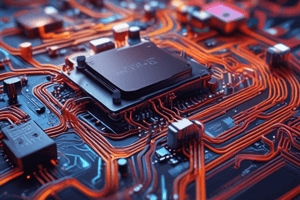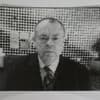Podcast
Questions and Answers
What does an electrical circuit contain at a minimum?
What does an electrical circuit contain at a minimum?
A voltage source, a load, and conductors to carry the electrical current.
A type of subatomic particle with a positive charge is a(n) ____
A type of subatomic particle with a positive charge is a(n) ____
Proton
Which of the following is considered an insulator?
Which of the following is considered an insulator?
- Porcelain (correct)
- Silver
- Gold
- Copper
The voltage commonly supplied to a residence by the local utility is ____
The voltage commonly supplied to a residence by the local utility is ____
Another term used for voltage is ____
Another term used for voltage is ____
The color band that represents tolerance on a resistor is the ____
The color band that represents tolerance on a resistor is the ____
In a parallel circuit, the total resistance is ____ the smallest resistance.
In a parallel circuit, the total resistance is ____ the smallest resistance.
Circuit continuity is checked using the ___ function of a multimeter.
Circuit continuity is checked using the ___ function of a multimeter.
The power in a circuit with 120 volts and 5 amps is ____
The power in a circuit with 120 volts and 5 amps is ____
Current is measured in units called ____
Current is measured in units called ____
Joules are ____
Joules are ____
All conductors have ____
All conductors have ____
To find voltage when both current and resistance are known, use the formula ____
To find voltage when both current and resistance are known, use the formula ____
A resistor with a color code of yellow, orange, red, and silver has a tolerance of ____
A resistor with a color code of yellow, orange, red, and silver has a tolerance of ____
Ammeters measure ____
Ammeters measure ____
The charged particles of an atom are called ____
The charged particles of an atom are called ____
Conductors have ____ or fewer valence electrons.
Conductors have ____ or fewer valence electrons.
The sum of the difference in potential of all the charges in an electrostatic field is called ____
The sum of the difference in potential of all the charges in an electrostatic field is called ____
Electric charge is measured in ____
Electric charge is measured in ____
Resistance is measured in ____
Resistance is measured in ____
Find the resistance when the voltage is 120V and the current is 6A.
Find the resistance when the voltage is 120V and the current is 6A.
An electromagnetic device used to control a mechanical device such as a valve is called a ____
An electromagnetic device used to control a mechanical device such as a valve is called a ____
A device containing one or more coils of wire wrapped around a common core is called a ____
A device containing one or more coils of wire wrapped around a common core is called a ____
A ____ is an electro-mechanical component used as a switching device.
A ____ is an electro-mechanical component used as a switching device.
The change in voltage across a component is called a ____
The change in voltage across a component is called a ____
A ____ circuit has only one route for current flow.
A ____ circuit has only one route for current flow.
A ____ is a drawing in which symbols are used to represent the components in a system.
A ____ is a drawing in which symbols are used to represent the components in a system.
A ____ is a component that normally opposes current flow in a DC circuit.
A ____ is a component that normally opposes current flow in a DC circuit.
____ is the rate of doing work or the rate at which energy is used or dissipated.
____ is the rate of doing work or the rate at which energy is used or dissipated.
_____ is a statement of the relationship between current, voltage, and resistance in an electrical circuit.
_____ is a statement of the relationship between current, voltage, and resistance in an electrical circuit.
An ___ is a material through which it is difficult to conduct an electric current.
An ___ is a material through which it is difficult to conduct an electric current.
Consisting of two or more cells, ____ convert chemical energy into electrical energy.
Consisting of two or more cells, ____ convert chemical energy into electrical energy.
The prefix used to indicate one million is ____.
The prefix used to indicate one million is ____.
The prefix used to indicate one thousand is ____.
The prefix used to indicate one thousand is ____.
____ is any substance that has mass and occupies space.
____ is any substance that has mass and occupies space.
An ____ is a negatively charged particle that orbits the nucleus of an atom.
An ____ is a negatively charged particle that orbits the nucleus of an atom.
The outermost ring of electrons orbiting the nucleus of an atom is known as the ____.
The outermost ring of electrons orbiting the nucleus of an atom is known as the ____.
Found in the nuclei of atoms, ____ are electrically positive particles and ____ are electrically neutral particles.
Found in the nuclei of atoms, ____ are electrically positive particles and ____ are electrically neutral particles.
The ____ is the center of an atom.
The ____ is the center of an atom.
The ____ is the smallest particle of an element that will still retain the properties of that element.
The ____ is the smallest particle of an element that will still retain the properties of that element.
The basic unit of measurement for electrical power is the ____.
The basic unit of measurement for electrical power is the ____.
Flashcards are hidden until you start studying
Study Notes
Electrical Circuits Concepts
- An electrical circuit requires at least a voltage source, load, and conductors.
- A proton is a positively charged subatomic particle.
- Common insulators include materials like porcelain, while metals like gold, copper, and silver are conductors.
Voltage and Current
- Typical household voltage supplied is 240 volts.
- Another term for voltage is electromotive force (emf).
- Current is measured in amperes, with power calculated using the formula P=IE; example: 120 volts and 5 amps equals 600 watts.
Resistors and Ohm's Law
- The fourth color band on a resistor indicates its tolerance.
- In parallel circuits, total resistance is less than the smallest resistance present.
- To find voltage when current and resistance are known, use E=IxR.
Measurement Tools
- Circuit continuity is checked with the ohmmeter function of a multimeter.
- Ammeters specifically measure current.
- Joules represent units of work and are associated with energy transfer.
Conductors and Insulators
- All conductors possess some resistance.
- Conductors typically have three or fewer valence electrons, enabling current flow; insulators are materials that resist electric current.
Electrical Components
- Solenoids are electromagnetic devices controlling mechanical devices like valves.
- Transformers consist of coils of wire around a common core for voltage adjustment.
- Relays function as electro-mechanical switches.
Circuit Types and Voltage Concepts
- A series circuit has only one path for current flow; a schematic is a symbolic representation of circuit components.
- Voltage drop refers to the change in voltage across a component in a circuit.
Energy and Power
- Power is the rate of doing work or the speed at which energy is used.
- Ohm's Law describes the relationship between current, voltage, and resistance.
Fundamental Electrical Concepts
- Insulators impede current flow, while batteries convert chemical energy into electrical energy, comprising two or more cells.
- The prefix "Mega" signifies one million; "Kilo" signifies one thousand.
- Matter is defined as any substance that has mass and occupies space.
Atomic Structure
- Electrons, negatively charged particles, orbit the atom's nucleus, which contains positively charged protons and electrically neutral neutrons.
- The valence shell is the outermost electron ring, while the nucleus is the atom's center.
- An atom is the smallest unit that retains an element's properties.
Power Measurement
- Power is measured in watts, the fundamental unit for electrical energy consumption.
Studying That Suits You
Use AI to generate personalized quizzes and flashcards to suit your learning preferences.





